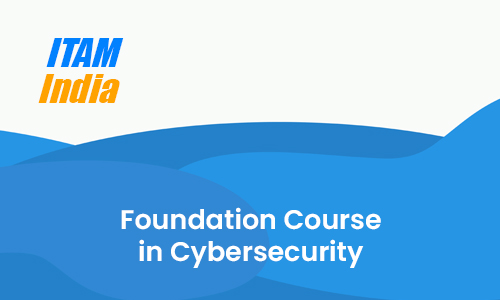Currently Empty: ₹0.00

Foundation Course in Cybersecurity
Course Description
The essential course for every security analyst & practitioner of Cyber Security.
This course is for
- For Entry Level,
- Oracle OpenJDK
- Refresher education at all levels; and for
- ITAM, FinOps & ITOM practitioners who need to have foundational knowledge in Cyber Security.
Begin your professional journey in cybersecurity with ITAM India's Foundations in Cyber Security program. This fast-track course is meticulously designed for individuals with no prior experience required, providing a robust foundation in essential cybersecurity principles.
The curriculum is structured to equip you with the fundamental knowledge necessary to confidently pursue the industry-recognized ITAM India certification. This program serves as an ideal entry point for aspiring professionals seeking a rewarding career in the dynamic field of cybersecurity.
The course teaches you how to secure devices and protect networks of all sizes, and manage both Linux and Windows systems.
Who Should Attend the course?
- Entry Level Security Analysts
- Everyone who wants to be a part of the IT Operations Management teams
- ITAM, FinOps & ITOM practitioners who need to have foundational knowledge in Cyber Security.
- Any IT Operations personnel who needs a refresher course with the latest in Cyber Security.
Certification
- Certificate in Cyber Security Foundations Plus
Exam Details
- Multiple Choice
- 100 questions
- 120 minutes
- 85% passing marks
Curriculum
- 6 Sections
- 31 Lessons
- 18.5 Hours
The total course can be conducted over 3 full days or 6 half-day sessions.
-
Session 1 (1 hour):
Security Principles4-
1.1Confidentiality, Integrity, and Availability (CIA Triad)
- Definitions and real-world examples
- Threats to each component
-
1.2Security Governance
- Security policies, standards, procedures, guidelines
- Risk management and threat modeling basics
-
1.3Defense-in-Depth Strategy
- Layered security concept (physical, network, application, data)
- Preventive, detective, corrective controls
- 1.4Security Roles & Responsibilities
- Security vs compliance vs audit
- Roles: data owner, data custodian, user, security officer
-
-
Session 2 (2.5 hours):
Business Continuity (BC) and Disaster Recovery (DR)5-
1.1Business Continuity (BC) and Disaster Recovery (DR)
- Purpose and scope
- Business Impact Analysis (BIA)
-
1.2Disaster Recovery Planning (DRP)
- Types of disasters (natural, technical, human)
- DR process and testing
-
1.3Recovery Metrics
- RTO (Recovery Time Objective) and
- RPO (Recovery Point Objective)
- 1.4Backup Strategies
- Full, incremental, differential, snapshot backups
- Off-site, cloud-based backups
- 1.4Disaster Recovery Site Types
- Hot, Warm, and Cold sites
- Mobile DR units and cloud DR
-
-
Session 3 (3 hours):
Access Controls5-
1.1Identification, Authentication, Authorization, Accounting (IAAA)
-
1.1Authentication Factors
- Something you know/have/are/do/where you are
- Examples of each (e.g., passwords, tokens, biometrics)
-
1.1Multi-Factor Authentication (MFA)
- Use cases and implementation
-
1.1Access Control Models
- RBAC (Role-Based Access Control)
- DAC, MAC, ABAC
-
1.1Provisioning and De-provisioning
- Onboarding and offboarding procedures
- Least privilege and need-to-know principles
-
-
Session 4 (3.5 hours):
Network Security7-
1.1Basic Network Concepts
- OSI Model basics
- TCP/IP stack
-
1.1Firewalls
- Packet filtering, stateful, application proxy
-
1.1Intrusion Detection and Prevention (IDS/IPS)
- Signature-based vs anomaly-based
-
1.1Virtual Private Networks (VPNs)
- IPSec vs SSL VPNs
- Encryption and tunnelling protocols
-
1.1Secure Network Protocols
- HTTPS, SSH, TLS, SFTP, DNSSEC
-
1.1Wireless Security
- WPA2/WPA3, 802.1X, rogue APs
-
1.1Segmentation and Zoning
- VLANs, DMZs, NAC
-
-
Session 5 (3 hours):
Security Operations5-
1.1Logging and Monitoring
- SIEM basics
- Event vs log vs alert
-
1.1Incident Response (IR)
- IR Lifecycle: Preparation, Identification, Containment, Eradication, Recovery, Lessons Learned
- Roles and responsibilities during an incident
-
1.1Forensics Basics
- Chain of custody, preservation of evidence
-
1.1Escalation Procedures
- Communication channels and incident severity levels
-
1.1Security Awareness
- User education, phishing simulations, reporting mechanisms
-
-
Session 6 (2.5 hours):
Practice Exam & Q&A5-
1.1Sample Questions
- 30–50 realistic exam-style multiple-choice questions
- Explanation of correct answers
-
1.1Common Exam Traps
- Misleading terms, distractors, and "best answer" questions
-
1.1Key Takeaways from Each Domain
-
1.1Exam Preparation Tips
- Time management, stress reduction, how to approach difficult questions
-
1.1Open Q&A Session
- Review weak areas and learner queries
-
Ritesh Verma leads the technical service delivery and project management. He is responsible for discovery and analytical tools for Oracle products and SAM Managed services.
Previously, Ritesh was the CIO of Indian Oiltanking & has implemented multiple Oracle applications in his 25 year career. He sits on the board of a Cloud and IT Services firm.
Previously, Ritesh was the CIO of Indian Oiltanking & has implemented multiple Oracle applications in his 25 year career. He sits on the board of a Cloud and IT Services firm.
Featured Review
The Cyber Security course by ITAM India, led by Ritesh Verma, was outstanding. Ritesh’s expertise and engaging teaching style made complex topics accessible. The course offered practical solutions and real-world scenarios, boosting my confidence in managing cyber risks. I highly recommend this program to anyone serious about cybersecurity.
Schedule:
Day 1: 23rd Aug 2025, 10am to 2pm
Day 2: 24th Aug 2025, 10am to 2pm
Day 3: 29th Aug 2025, 10am to 2pm
Day 4: 30th Aug 2025, 10am to 2pm
Day 4: 31st Aug 2025, 10am to 2pm
00
days
00
hours
00
minutes
00
seconds
Details
Topic:
Foundation Course in Cybersecurity
Hosted By:
Ritesh Verma
Start:
Sat, Aug 23, 2025 10:00 AM
Category:
August 2025, Instructor Led Online
Duration:
20 hours 0 minutes
Current Timezone:
Asia/Kolkata
Note: Countdown time is shown based on your local timezone.



